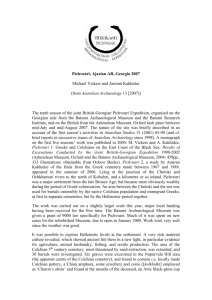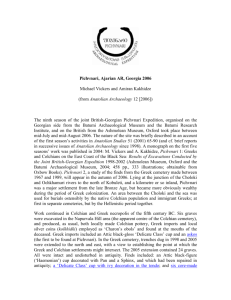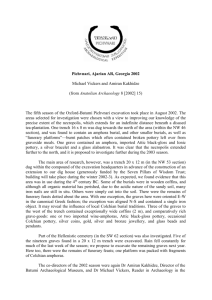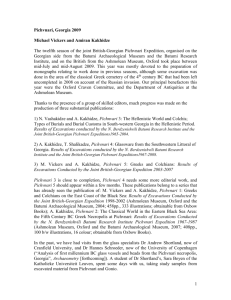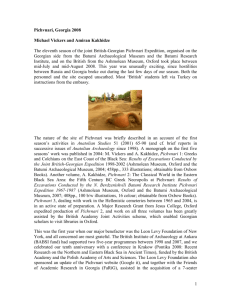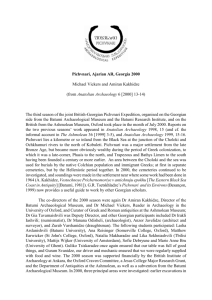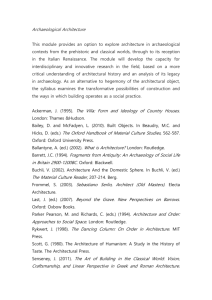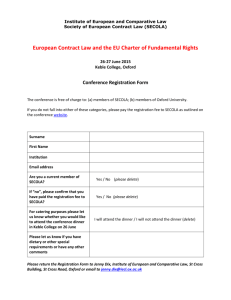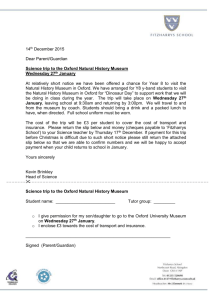doc - University of Oxford
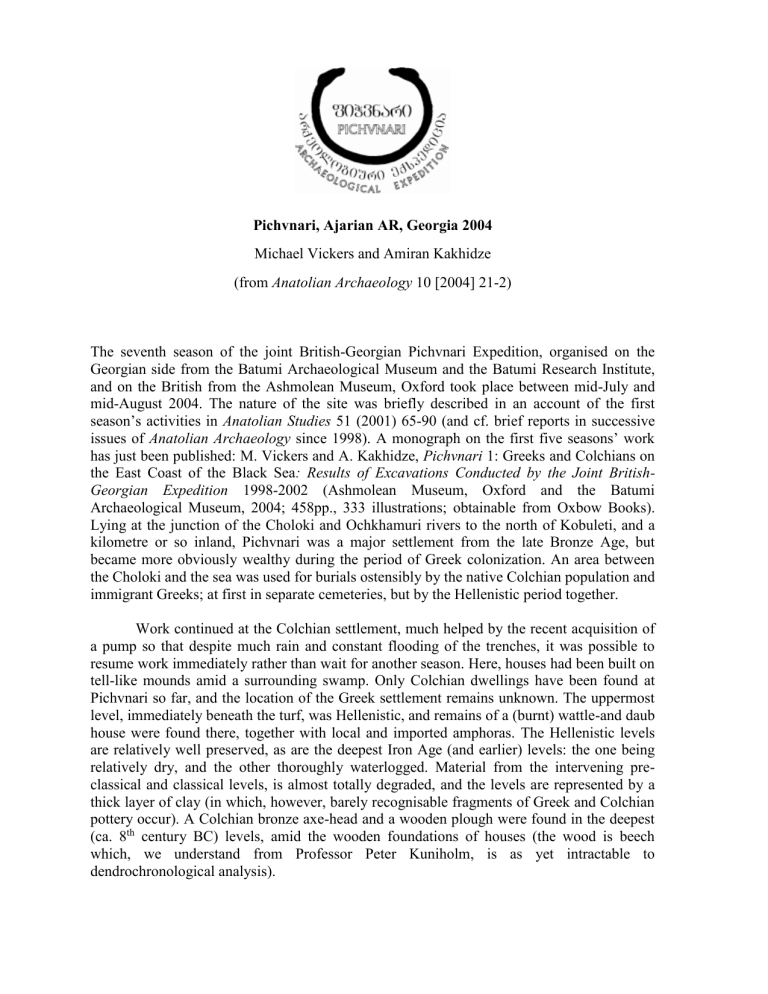
Pichvnari, Ajarian AR, Georgia 2004
Michael Vickers and Amiran Kakhidze
(from Anatolian Archaeology 10 [2004] 21-2)
The seventh season of the joint British-Georgian Pichvnari Expedition, organised on the
Georgian side from the Batumi Archaeological Museum and the Batumi Research Institute, and on the British from the Ashmolean Museum, Oxford took place between mid-July and mid-August 2004. The nature of the site was briefly described in an account of the first season’s activities in
Anatolian Studies 51 (2001) 65-90 (and cf. brief reports in successive issues of Anatolian Archaeology since 1998). A monograph on the first five seasons’ work has just been published: M. Vickers and A. Kakhidze, Pichvnari 1: Greeks and Colchians on the East Coast of the Black Sea : Results of Excavations Conducted by the Joint British-
Georgian Expedition 1998-2002 (Ashmolean Museum, Oxford and the Batumi
Archaeological Museum, 2004; 458pp., 333 illustrations; obtainable from Oxbow Books).
Lying at the junction of the Choloki and Ochkhamuri rivers to the north of Kobuleti, and a kilometre or so inland, Pichvnari was a major settlement from the late Bronze Age, but became more obviously wealthy during the period of Greek colonization. An area between the Choloki and the sea was used for burials ostensibly by the native Colchian population and immigrant Greeks; at first in separate cemeteries, but by the Hellenistic period together.
Work continued at the Colchian settlement, much helped by the recent acquisition of a pump so that despite much rain and constant flooding of the trenches, it was possible to resume work immediately rather than wait for another season. Here, houses had been built on tell-like mounds amid a surrounding swamp. Only Colchian dwellings have been found at
Pichvnari so far, and the location of the Greek settlement remains unknown. The uppermost level, immediately beneath the turf, was Hellenistic, and remains of a (burnt) wattle-and daub house were found there, together with local and imported amphoras. The Hellenistic levels are relatively well preserved, as are the deepest Iron Age (and earlier) levels: the one being relatively dry, and the other thoroughly waterlogged. Material from the intervening preclassical and classical levels, is almost totally degraded, and the levels are represented by a thick layer of clay (in which, however, barely recognisable fragments of Greek and Colchian pottery occur). A Colchian bronze axe-head and a wooden plough were found in the deepest
(ca. 8 th
century BC) levels, amid the wooden foundations of houses (the wood is beech which, we understand from Professor Peter Kuniholm, is as yet intractable to dendrochronological analysis).
Otherwise, work continued in the Hellenistic part of the cemetery, completing and extending an area begun in 2002. The upper levels consisted in places of what can only be described as Soviet archaeology, with bits of wire (from the wire-fence factory that formerly stood nearby), broken pottery from the house next door, conveniently datable thanks to a domestic informant to tell us when each piece was broken, and glass fragments, mostly from
Borjomi mineral water bottles. We cleared a score of graves dating to the late 4 th
century BC, as well as the occasional ‘ritual platform’ (a burnt area full of broken pots, where the ancients held their funeral feasts). The most interesting burials were a close-set group of four, one of which produced a silver finger ring bearing an intaglio portrait of Berenice I; another nearby contained a mass of lead fishing weights at the west end. Other significant finds were a glass bead with a moulded head of Heracles, and a silver coin of Sinope.
The co-directors of the 2004 season were again Amiran Kakhidze, Director of the
Batumi Archaeological Museum and currently acting Rector of Batumi State University, and
Michael Vickers, Professor of Archaeology in the University of Oxford, and Curator of
Greek and Roman antiquities at the Ashmolean Museum; Dr Gia Tavamaishvili was Deputy
Director, and other Georgian participants included Dr Manana Odisheli, Dr Irakli
Chevleishvili, Dr Merab Khalvashi, Ms Nino Dzneladze (archaeologists), Dr Emzar
Kakhidze (historian), Anzor Javelidze (architect and surveyor), Nargize Surmanidze (storekeeper), (Zurab Varshanidze (laboratory assistant); students: Lasha Bazhunaishvili (Batumi
State University), Inga Iashvili (Batumi State University), Miranda Turmanadze (Tbilisi
State University), and Suliko Svanidze (Batumi State University). The following visiting students participated: Alex Copley (University College, Oxford), Gus Docx (Keble College,
Oxford), David Freeman (Keble College, Oxford), Victoria Ing (Keble College, Oxford),
Dalia Iskander (Keble College, Oxford), Louis MacLaren (St Andrews University), and
Gabriela Pechanova (University of West Bohemia). Guliko Tsiskaradze cooked superbly, and Guram Svanidze ensured that we never went short of supplies. The 2004 season was supported financially by the British Institute of Archaeology at Ankara, the Oxford Craven
Committee, the Oxford Marjory Wardrop Committee, the Department of Antiquities at the
Ashmolean Museum, the Oxford Institute of Archaeology, the Seven Pillars of Wisdom
Trust, and the Batumi Archaeological Museum. Many thanks are due to all concerned.
